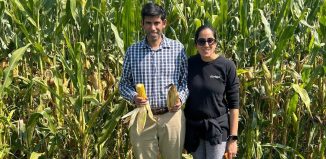Professor is ‘rising star in cancer research’
During a walk in a past autumn, Mikala Egeblad noticed a red leaf on the ground, surrounded by green leaves.
“It was very striking,” she said. “My first thought when I saw that was, ‘if only you could see the first cancer cells, to have them stand out.’”
Egeblad’s observation stems from her research, where the assistant professor at the picturesque not-for-profit Cold Spring Harbor Laboratory dedicates her working hours to studying the tumor microenvironment (the cells and material around a tumor) for pancreatic and breast cancers.
“The cancer cell is not alone,” said Egeblad. “It needs a support network. That comes from the body’s normal cells. The tumor is hijacking [those other cells] to fit its needs. Our idea is to try to take away the support line.”
Originally from Denmark, Egeblad likened her approach to the way the Danish Resistance fought the occupying army from Germany in World War II. Recognizing that they were unlikely to defeat the Germans head on, they disrupted trains and sabotaged factories.
Similarly, Egeblad is exploring ways to prevent tumors from corrupting nearby supporting cells. She wants to block the signals the tumors send out and prevent the microenvironment from receiving those malevolent cellular instructions.
Last year, she helped discover that inhibition of a receiver for chemokines (a chemokine receptor) in the tumor microenvironment makes breast cancer more responsive to chemotherapy.
She has also looked specifically for molecules that are different between normal and hijacked cells in fibroblasts or secreted by fibroblasts. Fibroblasts are cells that help provide a structural framework for tissues by secreting fibers and other substances.
She is collaborating on this research with Scott Powers, another scientist at CSHL. Using fluorescent proteins modified from those expressed by jellyfish, she can also see how fibroblasts and immune cells move around and interact. Seeing how these cells move, or whether they stop, she said, provides insights into what they do.
In cell cultures (i.e., not in live subjects), factors she adds from bacteria can enhance the immune cell’s ability to kill tumor cells. The activated immune cells can kill 90% of the breast or pancreatic cells from advanced tumors. She is focusing on understanding why the last 10% are not killed, because she thinks this is the key to get the method to work in tumors, where it currently is ineffective.
A researcher who wants to see how cancers work, Egeblad co-developed a spinning disk confocal microscopy system in which she can observe live cancers in action in mice.
Egeblad’s collaborators praised her work and her dedication.
Calling Egeblad a “rising star in cancer research with an international reputation,” Andrew Ewald, an assistant professor at Johns Hopkins, has worked with the CSHL scientist for over five years.
Egeblad came to scientific research through medicine. She was originally planning to become a doctor. As part of her medical training, she worked in a lab where she explored how things worked in relation to disease.
She decided she wanted to “understand how these diseases are developing” and wanted to try to “find new approaches to stop diseases.”
The fight against cancer is personal for Egeblad, whose grandmothers died from breast cancer and glioblastoma.
Egeblad has “chosen hard problems and understood they’d be difficult to solve,” Ewald said. “She has worked tirelessly and relentlessly to solve them anyway, with a great deal of success.”
Ewald said his collaborator has approached her work with a passion to “improve patient outcomes. The faster we can go, the more people we can help.”
A resident of Cold Spring Harbor, Egeblad lives with her long-term partner and their young daughter. Growing up in northern Copenhagen, she found some similarities to her home landscape. From the coastline of Copenhagen, residents can see Sweden. Standing on the shores of Long Island, she can view Connecticut.
As for her lab, her longer term interest is to understand the communication that goes on between cancer and normal cells.
“I want to know if communications between cancer cells and cells in the microenvironment changes the fate of the cancer cells in the long term,” she suggested. She is particularly interested in whether a tumor relapses years after an apparent cure.






